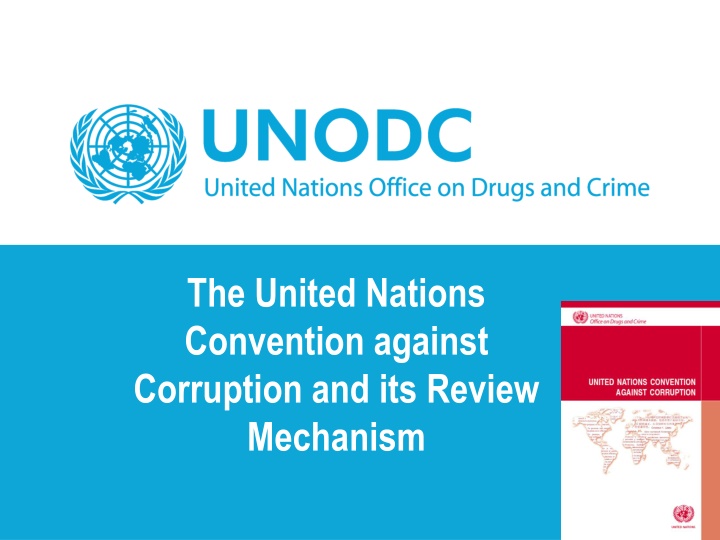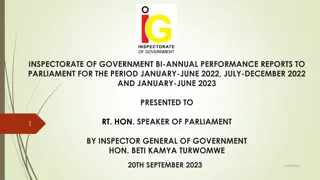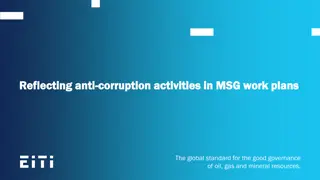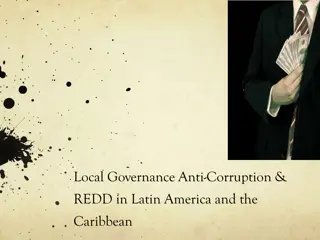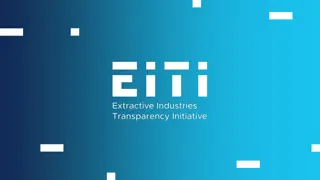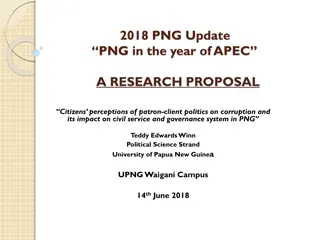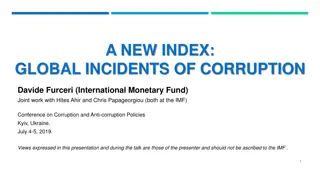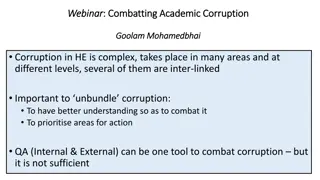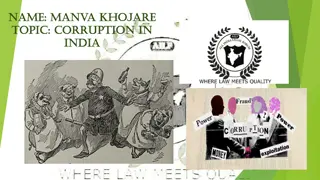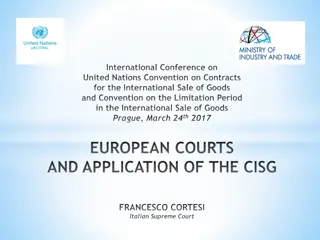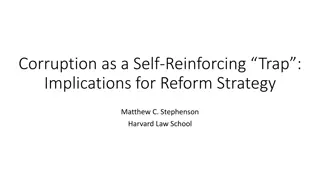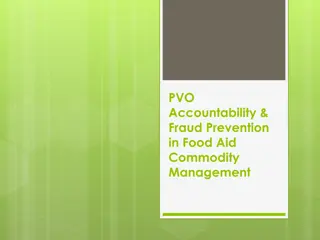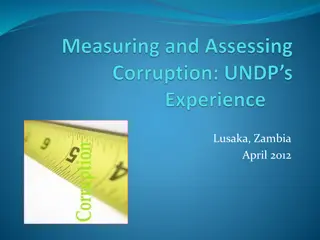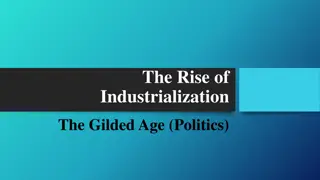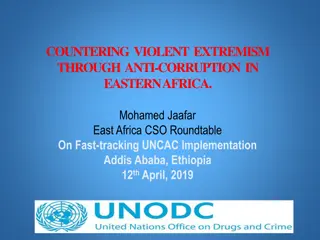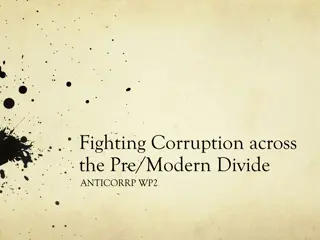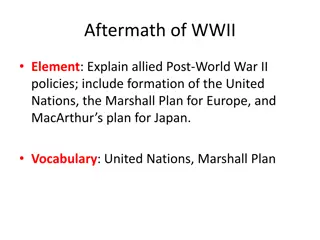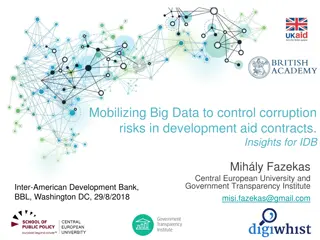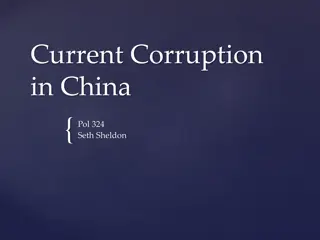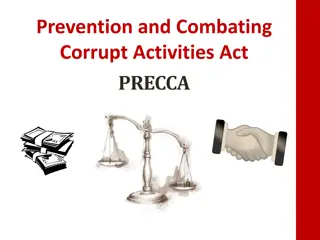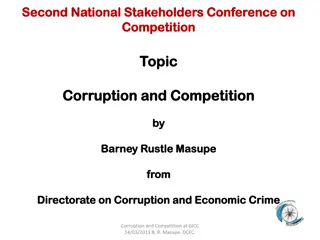United Nations Convention Against Corruption - Overview
The United Nations Convention against Corruption (UNCAC) is a global effort to combat corruption through preventive measures, criminalization, law enforcement, international cooperation, and asset recovery. The Convention, adopted in 2003, sets out mandatory provisions and obligations for States Parties to prevent and address corrupt practices. Decision-making bodies and implementation mechanisms play key roles in promoting transparency and accountability worldwide.
Download Presentation

Please find below an Image/Link to download the presentation.
The content on the website is provided AS IS for your information and personal use only. It may not be sold, licensed, or shared on other websites without obtaining consent from the author.If you encounter any issues during the download, it is possible that the publisher has removed the file from their server.
You are allowed to download the files provided on this website for personal or commercial use, subject to the condition that they are used lawfully. All files are the property of their respective owners.
The content on the website is provided AS IS for your information and personal use only. It may not be sold, licensed, or shared on other websites without obtaining consent from the author.
E N D
Presentation Transcript
The United Nations Convention against Corruption and its Review Mechanism
1. General information related to the Convention 2. Decision-making bodies 3. Implementation Review Mechanism 4. Self-assessment checklist 5. Tools to assist in the reviews
The United Nations Convention against Corruption Adopted by the General Assembly: Resolution 58/4, 31 October 2003 Entry into Force: 14 December 2005 186
The United Nations Convention against Corruption Preventive measures Criminalization and law enforcement International cooperation Asset recovery
Levels of obligation Levels of obligation 1. Mandatory provisions 1. Mandatory provisions Each State Party shall disallow the tax deductibility of expenses that constitute bribes [ ] (art. 12, para. 4) 2 2. . Obligation Obligation to to consider/endeavour consider/endeavour to to adopt Each State Party shall consider taking, in accordance with the fundamental principles of its domestic law, disciplinary or other measures against public officials who violate the codes [ ] (art. 8, para. 6) adopt 3 3. . Optional Optional provisions Where appropriate, States Parties may also give special consideration to concluding agreements or mutually acceptable arrangements, on a case-by- case basis, for the final disposal of confiscated property (art. 57, para. 5). provisions
1. General information related to the Convention 2. Decision-making bodies 3. Implementation Review Mechanism 4. Self-assessment checklist 5. Tools to assist in the reviews
The Conference of the States Parties (art. 63) CoSP 7 Nov. 2017 Austria Promote and review implementation CoSP 6 Nov. 2015 Russian Federation Make recommendations CoSP 5 Nov. 2013 Panama Facilitate information exchange CoSP 4 Oct. 2011 Morocco CoSP 3 Nov. 2009 Qatar CoSP 2 Jan 2008 Indonesia CoSP 1 Dec 2006 Jordan
Subsidiary bodies to the Conference of the States Parties Implementation Review Group Open-ended Intergovernmental Working Group on Prevention Open-ended Intergovernmental Working Group on Asset Recovery Open-ended intergovernmental expert meetings to enhance international cooperation under the Convention
1. General information related to the Convention 2. Decision-making bodies 3. Implementation Review Mechanism 4. Self-assessment checklist 5. Tools to assist in the reviews
The Implementation Review Mechanism Art. 63, para. 7: [ ] the Conference of the States Parties shall establish, if it deems it necessary, any appropriate mechanism or body to assist in the effective implementation of the Convention.
Working Group for Review of Implementation - Implementation Review Group Established by the Conference at its first session (Jordan, 2006) Tasked with preparing terms of reference of a review mechanism at the second session of the Conference (Indonesia, 2008) Implementation Review Mechanism established at the third session of the Conference (resolution 3/1, Doha, 2009)
Third session of the Conference of the States Parties Doha, from 9 to 13 November 2009 Resolution 3/1: Establishes the Implementation Review Mechanism Contains the terms of reference for the Mechanism Based on the outcome of the deliberations in the Implementation Review Group doha2009inside
Overview of the Terms of Reference Peer review process Drawing of lots for each year of the review cycle Each phase = two cycles of five years (2010-2015; 2016-2021) First cycle: Chapters III (Criminalization and law enforcement); and IV (International cooperation) Second cycle: Chapters II (Preventive measures); and V (Asset recovery)
Goals of the Mechanism: (para. 11, Goals of the Mechanism: (para. 11, TORs) TORs) Assist States parties in their implementation of the Convention Assist States parties in their implementation of the Convention Help States parties to identify and substantiate specific needs for technical assistance and to promote and facilitate the provision of technical assistance; Promote and facilitate international cooperation in the prevention of and the fight against corruption, including in the area of asset recovery; Promote and facilitate the exchange of information, practices and experiences gained in the implementation of the Convention;
Guiding principles Non adversarial/ non punitive/ no rankings Opportunity to share good practices and challenges Assist States in implementing the Convention Balanced geographical approach Technical/ Intergovernmental nature Complement existing review mechanisms Diversity of legal systems and levels of development Confidentiality
Stages of the review 1) Self-assessment 2) Desk review 3) Dialogue between State under review and reviewing States 4) Direct dialogue (country visit or joint meeting) 5) Final review report and executive summary What is the timeframe? Role of the Secretariat
Module schedule for country reviews Start: 29 June 2019 Preferably within 5 months (29 November) Within 1 month (29 July) Secretariat organizes tele/videoconference: Submission of SACL Language of review Division of labour Active dialogue Within 3 weeks (20 July) Within 2 months (29 August) Within 6 months (29 December 2019) State under review nominates focal point State under review submits self-assessment Secretariat circulates checklist to reviewing experts, after translation Within 1 month (29 September) Deadline for reviewing expert nominations: 6 July Reviewing experts submit outcome of the desk review Within 1 month (29 October) Secretariat organizes tele/video conference to introduce outcome of the desk review Dialogue: up to 2 months (until 29 December 2018) Reviewers prepare draft country report assisted by secretariat, State under review agrees to final report, executive summary is prepared State under review organizes direct dialogue, facilitated by secretariat (joint meeting or country visit) End of review
Looking forward First cycle: moving towards completion 164 executive summaries now completed and available More are nearing finalization Second cycle: Prevention and Asset Recovery Launch of 2nd cycle start of reviews: 4 July 2016 Development of expertise and good practices in these areas Lessons learned from first cycle
1. General information related to the Convention 2. Decision-making bodies 3. Implementation Review Mechanism 4. Self-assessment checklist 5. Tools to assist in the reviews
Documents for the Review Mechanism Convention COSP resolutions Terms of Reference of the Review Mechanism Guidelines for Governmental experts and the Secretariat Blueprint for country review reports and executive summaries Guidance document for filling in self-assessment checklist Executive Summaries and other documents available on UNODC Website: http://www.unodc.org/unodc/en/treaties/CAC/country-profile/index.html
1. General information related to the Convention 2. Decision-making bodies 3. Implementation Review Mechanism 4. Tools to assist in the reviews
The self-assessment checklist Used in the first cycle Adapted for the second cycle and approved by the Implementation Review Group in June 2016 Parts to be answered: General information, chapters II and V Available for download from our website: http://www.unodc.org/unodc/en/treaties/CAC/self- assessment.html Also available: Self-assessment checklist as PDF document Guidance notes
Question flow in the self-assessment checklist 1. Is your country in compliance with this provision? Yes/Yes, in part/No 2. Please describe (cite and summarize) the measures/steps your country has taken, if any, (or is planning to take, together with the related appropriate time frame) to ensure full compliance with this provision of the Convention. 3. Please provide examples of the implementation of those measures, including related court or other cases, available statistics etc.
Additional resources: Travaux pr paratoires Legislative Guide Technical Guide State of implementation report Additional tools (e.g. art. 11, StAR Initiative documents)
For further information: Vienna International Centre Corruption and Economic Crime Branch United Nations Office on Drugs and Crime P.O.Box 500 Vienna A-1400 Austria Tel: +43-1-26060-4913 Fax: +43-1-26060-5841 http://www.unodc.org/unodc/en/corruption/implementation-review- mechanism.html
